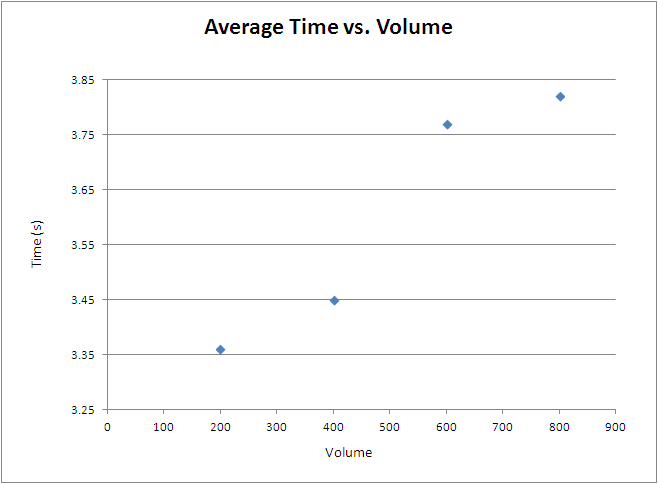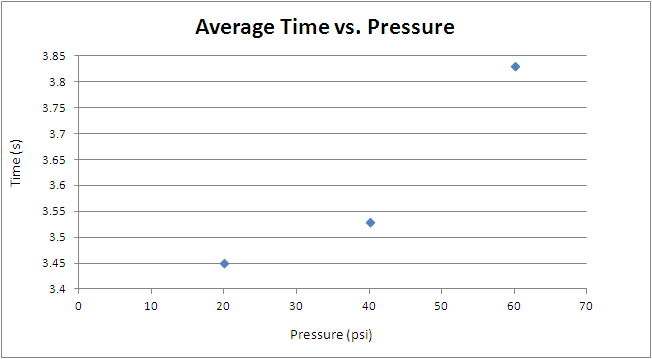

Allan Sanders, Bailee Johnstone, Vanessa Chizum
IB Physics 2
May 21, 2013
Introduction :. Method :. Results/Data :. Videos :. Conclusion :. Sources .:. Return to Research
Background Information:
A water rocket is simply a rocket propelled by water acting as its counter mass. The water powered rocket operates using water propulsion and hand-pump generated air pressure (4). The way that a water rocket works is that the rocket is launched as the water is propelled out of the bottom by the pressurized air sitting above it in the rocket. The thrust portion of flight for a water rocket is composed of up to three phases, each identified by the thing that is being expelled from the rocket at the time: launch tube, water, and gas (1). When the water runs out, then the rocket continues rising until the force of gravity makes the rocket plummet to the earth. Water rockets can achieve upward velocities on the order of 70m/s (157 mph). For this to happen, a significant amount of the energy stored in the pressurized gas is converted into kinetic energy of the rocket. This conversion is a very rapid process, since the thrust phase generally takes about 1/10 second. The use of a launch tube and the proper amount of water in the rocket serve to increase the efficiency of this conversion (1). Our variables during this experiment will be independent: water pressure in rocket and amount of water; dependent: time rocket spends in the air; controlled: angle of launched rocket, type of fluid, same launcher base, same rocket, same fin position and angle.
Purpose/ Question:
What water pressure and amount of water inside of a water rocket, if the rocket is launched straight up, will allow the rocket to remain in the air the longest?
(Variables: Independent- Water pressure inside the rocket (maximum of 60 psi), amount of water (measured in mL; maximum of 800 mL)
Dependent- Time rocket spends in the air
Controlled- Angle of launched rocket, type of fluid inside rocket, same launcher and rocket)
Hypothesis: If a rocket is launched straight up, then maximum time in the air will be reached if there are 600 mL of water at a pressure 40 psi inside the water rocket because this will give the rocket a maximum amount of counter thrust.
The easiest and most basic way to build one of your own is to use a two-liter soda bottle, emptied of its original contents, with the original label and cap ring removed, with added fins that can expand with the bottle for drag, and finally a nose made out of a second two liter bottle (3).
Diagram:

For our experiment, we needed a launcher base (pre-built; base has launch tube, pressure gauge, nozzle for pump, and launch pin), a water rocket [made from 2 liter plastic soda bottles, tape, and fins (cardboard, duct tape), a graduated beaker (1000 mL preferably), water, two stopwatches, and a pump with pressure gauge (up to at least 60 psi). Then, we took all materials to a field or open area. We measured and poured the amount of water we wanted each trial into the rocket. Then, tilting the base up so the water would not spill, we gently slipped the open end of the water rocket over the end of the launch tube. Then, we inserted the launch pin and made sure the rocket was firmly in place. Next, we attached the pump to the nozzle on the base, and pumped until the wanted pressure was reached. Finally, all personnel stepped back and one person held the string with the launch pin, counted down from 3, and pulled the pin. Two people with stopwatches timed the time from the rocket being launched to the time when it hit the ground. We then recorded the times on a sheet of paper, and proceeded to average them. For each volume of water measured (200 mL, 400 mL, 600 mL, 800 mL), we applied three different pressures (20 psi, 40 psi, and 60 psi). For each pressure and volume (for example, 200 mL at 20 psi), we had three trials. In all, we had 36 trials.
From our experiment, we found that the best overall average time of the water rocket in the air was when the rocket was filled with 600 mL of water and had a pressure of 60 psi. This gave the rocket a maximum of 4.3 seconds in the air and an overall average of about 4.1 seconds.
DATA TABLE:
|
|
Trials (Time in seconds) |
|
|
|
|
Amount of Water (mL) |
1 |
2 |
3 |
Average |
|
200 (20 psi) |
2.62 2.7 |
2.91 3.08 |
3.21 3.36 |
|
|
Average |
2.66 |
2.99 |
3.285 |
2.98 |
|
200 (40 psi) |
3.48 3.45 |
3.82 3.73 |
3.4 3.48 |
|
|
Average |
3.465 |
3.775 |
3.44 |
3.56 |
|
200 (60 psi) |
3.5 3.46 |
3.55 3.51 |
3.61 3.58 |
|
|
Average |
3.48 |
3.53 |
3.595 |
3.54 |
|
400 (20 psi) |
3.2 3.15 |
3.57 3.6 |
3.32 3.26 |
|
|
Average |
3.175 |
3.585 |
3.29 |
3.35 |
|
400 (40 psi) |
3.15 3.23 |
3.0 3.2 |
3.9 3.7 |
|
|
Average |
3.19 |
3.1 |
3.8 |
3.36 |
|
400 (60 psi) |
3.6 3.63 |
3.7 3.69 |
3.59 3.62 |
|
|
Average |
3.615 |
3.695 |
3.605 |
3.64 |
|
600 (20 psi) |
3.9 3.81 |
3.2 2.9 |
3.5 3.36 |
|
|
Average |
3.85 |
3.55 |
3.42 |
3.61 |
|
600 (40 psi) |
3.3 3.12 |
3.7 3.63 |
3.9 3.92 |
|
|
Average |
3.21 |
3.665 |
3.91 |
3.6 |
|
600 (60 psi) |
4.0 4.1 |
4.2 3.99 |
4.01 4.3 |
|
|
Average |
4.05 |
4.095 |
4.155 |
4.1 |
|
800 (20 psi) |
3.8 3.82 |
3.9 3.94 |
3.78 3.8 |
|
|
Average |
3.81 |
3.92 |
3.79 |
3.84 |
|
800 (40 psi) |
3.5 3.55 |
3.63 3.59 |
3.61 3.6 |
|
|
Average |
3.525 |
3.61 |
3.605 |
3.58 |
|
800 (60 psi) |
4.07 4.0 |
4.1 4.08 |
4.0 3.95 |
|
|
Average |
4.035 |
4.09 |
3.975 |
4.03 |
| Average Time in the Air (s) | |||
| Volume (mL) | |||
| 800 | 3.84 | 3.58 | 4.03 |
| 600 | 3.61 | 3.6 | 4.1 |
| 400 | 3.35 | 3.36 | 3.64 |
| 200 | 2.98 | 3.56 | 3.54 |
| Pressure (Psi) | 20 | 40 | 60 |
Data - Text Format:
Data - Excel:
GRAPH:


200 mL at 20 psi : https://docs.google.com/file/d/0B83XIg5T-w2sVHhxSk1BMk40ZWM/edit
From our experiment, we found that the best overall average time of the water rocket in the air was when the rocket was filled with 600 mL of water and had a pressure of 60 psi. This gave the rocket a maximum of 4.3 seconds in the air and an overall average of about 4.1 seconds. In our hypothesis, we stated that the maximum could be found when using 600 mL of water at a pressure 40 psi. We were slightly incorrect on the pressure, but we definitely determined the correct amount of water. The rocket was about 30% full of water in the inner chamber which is important because the weight of the rocket was not altered so much as to leave the rocket grounded; at the same time the rocket was being pumped at our maximum psi. This gave the rocket enough thrust and counter force against the force of gravity and air friction to launch it into the air for the maximum amount of time on average. The main sources of error within this experiment could have been human error (measurement of water, timing errors, misreading of pressure etc.) as well as the weather; while doing this experiment, the weather was very cold and the outside temperature began to affect the rocket’s shape towards the very end of our experiment. If we were to do this experiment again, we would test the rocket’s maximum volume and psi beforehand to ensure the widest range of results. In addition, we could also change the liquid inside the rocket to see how that affects the launch and thrust of the water rocket.
1. Brannen, Carl. "Water Rocket Physics." Physics. Meta, 21 Mar. 2011. Web. 1 Nov. 2012. <http://physics.stackexchange.com/questions/7340/water-rocket-physics>. Good for general info
2. "Water Rocketry - About Bottle Rockets." Water Rocketry - About Bottle Rockets. N.p., n.d. Web. 01 Nov. 2012. <http://microgravity.grc.nasa.gov/education/rocket/BottleRocket/about.htm>. NASA- History of water rockets
3. "Bottle Rockets." Bottle Rockets. N.p., n.d. Web. 01 Nov. 2012. <http://tclauset.org/21_BtlRockets/BTL.html>. How to build a water bottle rocket step by step videos
4. "Water Propelled Rocket." ScienceBits. N.p., n.d. Web. 01 Nov. 2012. <http://www.sciencebits.com/RocketEqs>. Rocket Mechanics
5. "Rocket Thrust." Rocket Thrust. N.p., n.d. Web. 01 Nov. 2012. <http://microgravity.grc.nasa.gov/education/rocket/rktth1.html>. Good for all types of rockets/ science behind rockets
6. "Water Bottle Rockets." BBC News. BBC, n.d. Web. 01 Nov. 2012. <http://www.bbc.co.uk/bang/handson/waterbottlerockets.shtml>. Good Diagrams, pictures, setup for the water rockets of all types